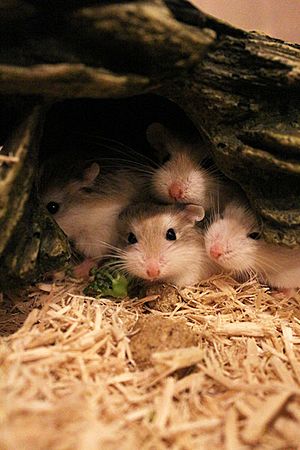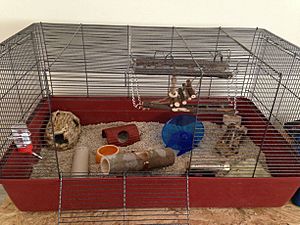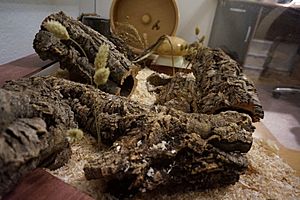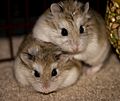Roborovski dwarf hamster facts for kids
Quick facts for kids Roborovski hamster |
|
|---|---|
 |
|
| Conservation status | |
| Scientific classification | |
| Genus: |
Phodopus
|
| Species: |
roborovskii
|
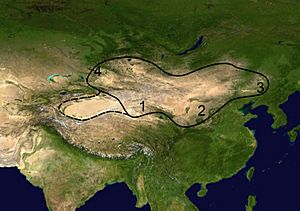 |
|
| Distribution of P. roborovskii | |
The Roborovski hamster (Phodopus roborovskii), also called the desert hamster or Robo dwarf hamster, is the smallest type of hamster. It belongs to the genus Phodopus. At birth, they are less than 2 centimetres (0.8 in) long. As adults, they grow to be about 4.5–5 centimetres (1.8–2.0 in) long and weigh 20–25 grams (0.71–0.88 oz).
You can tell Roborovskis apart by their white spots above their eyes, which look like eyebrows. They also don't have a dark stripe down their back, which other hamsters in their group do have. Roborovski hamsters usually live for about three years. However, this can change depending on where they live. In captivity, they can live up to four years, but in the wild, only about two years. These hamsters are famous for how fast they are. People say they can run as much as four human marathons every night!
Contents
Where Roborovski Hamsters Live
Roborovski hamsters live in desert areas. You can find them in places like the Zaysan Lake basin in Kazakhstan. They also live in parts of Tuva, Mongolia, and Xinjiang in China. These hamsters prefer areas with loose sand and not many plants. They usually avoid places with thick plants or hard clay ground.
They live at high elevations, around 1,200 metres (3,900 ft) to 1,450 metres (4,760 ft) above sea level. Even though scientists have studied them, we don't have any old fossils of this species. Roborovskis are very good at saving water. This helps them live well in the dry steppe and desert regions. They dig deep burrows, which are like tunnels, up to six feet underground. In the wild, Roborovski hamsters are most active at dawn and dusk. This means they are crepuscular.
The Roborovski hamster is more common in the southern parts of its home range. For example, they are often seen in Yulin, Shaanxi, China. Locals in this city and in the sand dunes of the Ordos desert report seeing them often.
What Roborovski Hamsters Eat
Roborovski hamsters are omnivores. This means they eat both plants and meat. Their main diet includes grains, vegetables, fruits, and plants. They also eat small amounts of meat and insects. In winter, Roborovski hamsters stay underground. They survive by collecting and storing food in special rooms in their burrows during warmer months.
These hamsters mostly eat seeds. In Tuva, they mainly eat seeds from plants like sand alyssum and Nitre Bush. They also eat seeds from Siberian peashrub, Dracocephalum peregrinum, and milkvetch in the summer. They don't eat many plant leaves or stems.
In the Chinese province of Shaanxi, they are known to eat millet seeds. In Mongolia, insects like beetles, earwigs, and crickets are part of their diet. Some reports even say they eat snails.
In Tuva, they eat very little animal food. Studies in 1958 and 1959 showed that almost all the food in their cheek pouches was plant-based. Animal food was found in only a small percentage of hamsters.
How much food a Roborovski hamster eats each day depends on its body weight. Young hamsters eat more food compared to their weight than adult hamsters. Both young and adult hamsters collect food and store it in their burrows.
Roborovski Hamster Life Cycle
The mother hamster carries her babies for 20 to 22 days. She can have three to four litters of babies each year. Each litter usually has three to nine babies, with six being the average. Hamsters bred in captivity often have babies all year round.
When they are born, the baby hamsters weigh about 1 gram (0.035 oz) to 2.1 grams (0.074 oz). They are born without fur. Their incisor teeth and claws are visible, but their eyes, ears, and toes are still closed. After three days, their whiskers start to show. After five days, their first back hairs grow. Their toes separate after six days. By eleven days, their body is fully formed. The young hamsters open their eyes around day 14.
Roborovski Hamsters as Pets
Roborovski hamsters have become popular pets recently. However, they are best for watching rather than handling a lot. This is because they are very active and can get stressed easily. They are also harder to handle compared to other pet hamster types. Because of this, they are not suggested as pets for very young children.
On average, Roborovski hamsters live about 26 months when kept as pets. Some people claim they don't cause allergies. But Roborovski hamsters have been linked to causing asthma in owners who never had asthma before.
Sometimes, if a hamster gets something harmful on its fur, you might need to use a shallow dish of warm water to clean it. But normally, you should never bathe hamsters in water. It is very stressful for them. It can also remove important protective oils from their fur, which can be dangerous. Hamsters clean themselves often. Instead of water, you should offer them a sand bath to help them stay clean and healthy.
Housing
Unlike some other hamster species (like the Golden hamster), Roborovski hamsters can sometimes live in same-sex pairs or small groups. This works best if they have grown up together since they were young. A single Roborovski hamster or a pair should have a cage that is at least 50 x 100 cm. This is about 0.5 square meters. The cage should also have at least 15–20 cm of bedding. This allows them to dig tunnels, which they love to do naturally. However, more floor space and deeper bedding are always better for any hamster. Extra levels in a cage do not count as part of the main floor area.
Many hamster lovers use Aquariums or DIY (do-it-yourself) enclosures. These are often preferred because they can hold more bedding. They are also easy to find and can be cheaper than traditional wire cages. If hamsters in a group start fighting, you must separate them right away to prevent injuries.
Roborovski hamsters are very active. So, they need a proper wheel to run on. The best size for the wheel is still debated. However, most people agree that a wheel should be no bigger than 16.5 cm (6.5 inches). This is because Robos are small, and a bigger wheel might be too hard for them to move. Other experts suggest a diameter of 20 cm (8 inches).
Like many rodents, Roborovski hamsters naturally avoid large open spaces. They prefer to stay close to walls where they feel safe. It's very important to give them many hiding spots. You can do this by placing branches, tunnels, and other hiding places close together in their cage.
What to Feed Your Pet Robo
Based on what they eat in the wild, owners should feed their hamsters food that mainly contains grains and small seeds. You should also offer them animal protein. This can be in the form of mealworms, grasshoppers, or other insects. If you don't want to feed them live insects, you can buy dried ones. Some hamsters also like seafood, such as dried gammarus.
To help them act naturally, you should scatter their food around the cage. Hide it in different spots or bury it slightly under the bedding. About 1 teaspoon of food per hamster per day is a good amount.
Some foods that are not good for hamsters include:
- The green leafy parts of a Tomato (these are toxic)
- Meats that have a lot of fat
- Chocolate or candy
- Onions, garlic, and peppers (these can upset their stomach)
- All citrus fruits (they are too acidic)
- Apple seeds
- Aubergine
Always make sure your hamster has fresh water available. A small bowl is better than a water bottle. It lets them drink in a more natural and comfortable way.
Hamsters' incisor teeth never stop growing. They have a special system where their teeth grind against each other when they chew. This helps wear their teeth down. So, it's very important to give them chew toys.
Bedding and Sand Baths
Materials that can break into thin strands, like cotton wool or similar 'fluffy' bedding, are dangerous for hamsters. They can get tangled in it or eat it, which can cause serious health problems. Nesting material should be easy to shred and safe to digest. Good options include unscented toilet paper, moss, hay, or leaves.
Softwood shavings, like those from pine or cedar trees, are also not good. They contain harmful chemicals that can damage a hamster's respiratory system (their breathing). However, hardwood shavings, like aspen, are perfectly safe to use.
To make your Roborovski hamster's home feel more like its natural habitat, you should always provide a large bowl of sand. Chinchilla sand is the best choice. You can also use children's play sand. The sand must be dust-free. Bird sand is not suitable because it has sharp pieces, like broken shell shards. Dust bathing is a very important part of a hamster's daily routine. It helps keep their fur healthy and shiny by removing extra oils. You can keep the sand clean by sifting it or washing it with water and then drying it.
Images for kids
See also
 In Spanish: Hámster enano de Roborovski para niños
In Spanish: Hámster enano de Roborovski para niños



